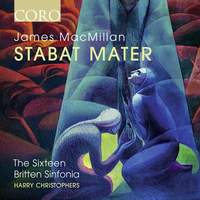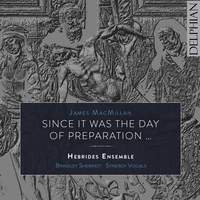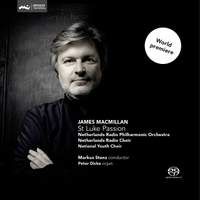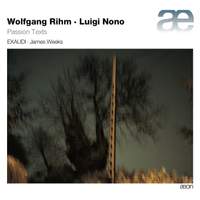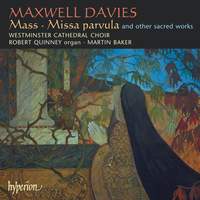Interview,
James MacMillan discusses his Stabat Mater
 Hot on the heels of our interview with Harry Christophers, we've also managed to talk to the composer himself! James MacMillan has just been speaking to me about the thinking behind his new work, the legacy of the Stabat Mater text, and the influence of his own religious beliefs - and also responded to some of Harry's thoughts. (You can read the full text of Harry's interview here).
Hot on the heels of our interview with Harry Christophers, we've also managed to talk to the composer himself! James MacMillan has just been speaking to me about the thinking behind his new work, the legacy of the Stabat Mater text, and the influence of his own religious beliefs - and also responded to some of Harry's thoughts. (You can read the full text of Harry's interview here).
As Harry Christophers mentions in his notes, the Stabat Mater has slightly fallen out of fashion among composers in recent years and decades (though with some exceptions, such as Arvo Pärt’s from 1985). Did you feel the sense of revitalising a dormant genre when you were writing your Stabat Mater?
The twentieth-century Stabat Maters have always been important to me – the Pärt and also the Szymanowski. I remember listening to them both and studying the latter when I was younger. There are various approaches to the Passion narrative that did fall into disuse but they all seem to be coming back. There’s a whole range of composers from Tan Dun to Wolfgang Rihm now who are writing versions of the Passion, and even versions by John Adams and Sofia Gubaidulina. The Seven Last Words is another structure that had fallen out of use, and Gubaidulina, again, returned to it – not as a choral setting but, like Haydn, as a reflection on the text. And I myself set the Seven Last Words 25 years ago.
I think in some ways the Stabat Mater had also fallen out of favour, but I have noticed that others have returned to it recently, too – James Dillon, for example, with the London Sinfonietta and the BBC Singers performing his setting a few years ago, and Cecilia McDowall has written one (which we gave the Scottish premiere of here at the Cumnock Tryst last year). So yes, in a way all these different forms had drifted out of the public consciousness, but for one reason or another (and I’m sure there are many) composers are finding a way back to them.
It’s tempting to view the poem as fairly monochromatic in its emotional content – the subject-matter is of unalleviated sadness and little else. How did you ensure that your musical setting of it didn’t end up equally maudlin?
There is a rhythmic thread to the poem that’s difficult to set, so I had to think very carefully about how I was going to divide it. I split the text equally into four groups of five, but I wanted to feel that there was a different character, not just from movement to movement but also within movements – that the mood could change and drift and develop throughout, so that you weren’t stuck in a groove, as it were. It was the same with the Seven Last Words, in a sense – Haydn had this problem too, in that each of his seven movements was an Adagio and he had to do something about that. There’s nothing monotonous about his setting, and that was a great encouragement to me. I too set the seven movements as Adagios - it couldn’t be anything else, really, because of the words.
In the Stabat Mater there’s actually more scope to vary the tempi, and some of the pulses and the general emotional mood. There are moments of drama, moments of horror, moments of pathos and moments of compassion. So even though it looks like a self-limiting choice, there are great possibilities of widening and varying the scope as the setting is made.
Compared to some of the instrumentations you’ve used recently (in Seven Angels and The Day of Preparation, for instance), the string orchestra might seem a little conventional. Why did you choose this particular texture to complement the choir?
It was to do with the choir itself. That was the first thing that came up in the early conversations with Harry Christophers; we talked about suitable sounds that might work. When I wrote my Seven Last Words it was basically the same scoring, for choir and string orchestra – and I really enjoyed working with those two sounds, both of which you might call quite monochrome. They establish their own world through their interaction which is quite unique, different and special, compared to something with choir and full orchestra or choir and organ. I was keen to get back to that soundworld: in this case the “sameyness” is really more of a virtue. Seven Angels was a very odd ensemble, with the trumpets and shofars, and that was a delight; there was a kind of self-limitation there in that there was only a handful of musicians, but there’s a lot of doubling for the trumpets so you can still push the boundaries. And likewise The Day of Preparation has that very strange quintet: even within that there are ways of finding new focus for the ear, where you might use one player or two, or the full quintet.
You’ve had a number of commissions by choirs with unique personalities and sounds – Ex Cathedra and The Sixteen being two of the most recent. How much do you tailor what you write to the specific choir (and indeed individuals) in question, and do you feel this shapes the overall form of the piece?
I think in the case of the works that I write for The Sixteen, most definitely. I’ve come to know the choir over the years and I’ve come to know them as individuals, so when I was writing the Stabat Mater I knew that this part was likely to be sung by a given person, and I could picture them and imagine their voice. That’s very helpful. There are other choirs, of course, that I write for without really knowing them, and one hopes that those pieces will have a life not just with that group but will find a place with other choirs too.
In his notes to the album, Harry mentions you in the same breath as Victoria and Poulenc – two other composers with a strong Catholic faith. Do you feel your religious beliefs directly influence the way you approach composition of sacred music?
It’s hard to say, really! I know that many of my colleagues are not necessarily religious, but nevertheless are very interested in setting religious texts: James Dillon is a case in point, and Peter Maxwell Davies, who was a great friend of mine, was not religious at all (he was quite hostile to religion, indeed) but he wrote a setting of the Mass for Westminster Cathedral and other sacred music for choirs. Not much of it, but it was something he enjoyed doing.
These texts are left to us like gifts from history. They’re gifts to modernity from Judaeo-Christian culture and civilisation, and in that sense they belong to us all. So any composer should feel free to embrace these texts if they want to, and make of them what they will.
With something like the Stabat Mater, though, it is a particularly Catholic way of thinking about the Crucifixion. I don’t know of many non-Catholics (except for Cecilia McDowall and Arvo Pärt, who is Orthodox) who have set it recently. Maybe that will change too, but it takes a particular kind of Catholic sensibility to see the Crucifixion through the eyes of Mary - and it’s probably an accident of history or culture that it’s Catholics who have mostly been drawn to the Stabat Mater.
Harry Christophers' world-premiere recording of MacMillan's Stabat Mater, with The Sixteen and the Britten Sinfonia, was released in March on Coro.
Available Formats: CD, MP3, FLAC, Hi-Res FLAC
Other recordings and works referenced in this interview
Available Formats: CD, MP3, FLAC, Hi-Res FLAC
Available Formats: CD, MP3, FLAC
Available Format: CD
Available Formats: 2 CDs, MP3, FLAC
Available Formats: CD, MP3, FLAC
Available Formats: CD, MP3, FLAC


